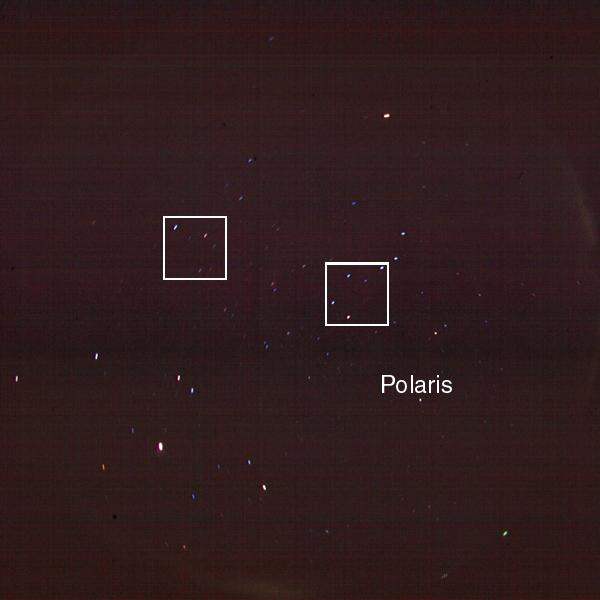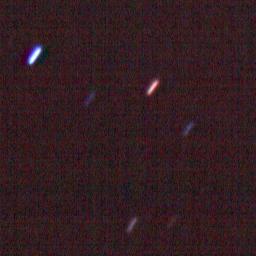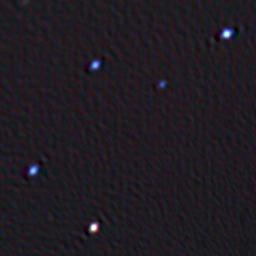
Some preliminary experiments to transform star trail images are reported. It is well known that due to the rotation of the earth the appearent location of stars and other objects on the sky move in circles. This movement manifests itself as trails when attempting to photograph the sky with a fixed camera. To obtain point shaped images of stars some means of contineous adjustment of the camera orientation is required. The maximum allowable exposure time for static cameras depends on the position of the star and the focal length of the photographic lens. Typically, exposure times of more than a few seconds are sufficent to visibly elongate star images. Many images of this kind can be found in textbooks or in the web, e.g. here.
Although the star trail image looks different to the point shaped image, it nevertheless contains more or less the same information, however, in a convoluted way. In theory, it should be possible to derive the point images by reversing this convolution process. The following idea for a deconvolution is analyzed in this article. Basically, it reverses the trail by applying a Wiener-filter with the trail being the proper point-spread function. This idea can not be applied in a straightforward manner since trails are different depending on the stars position. Also, trail shape depends on the lens projection characteristics, e.g. for the fisheye lens used in my tests trails are not circular. Hence, a remapping step is required prior to the Wiener-filter which equalizes all trails. A suitable format for this intemediate step is the equirectangular format which uses the stars angular coordinates as horizontal and vertical axis. In this format all trails are straight horizontal lines with equal length. After the application of the Wiener-filter these lines should collapse to a single point. Finally, the filtered equirectangular image is tranformed back to the original format, or whatever other projection characteristics is desired.
To summerize, these steps have to be performed:
The software used for these tests is my free package
Panorama Tools, which can be downloaded from this
site for many computer platforms. It really had not been developed
for astronomy application, hence the conventions for angular coordinates
and other parameters do not follow astronomical rules. Nevertheless, it
contains all required tools and transformation algorithms. To repeat the
example below some familiarity with the software is required and I suggest
to work through some of the panorama tutorials at my website. If further
experiments remain successful, more detailed tutorials will be published.
The Example:
This image below was taken with the Olympus OM 8mm Zuiko-fisheye lens covering 180° field of view. The camera was fixed in a not accurately aligned vertical position. Exposure time was 5 minutes with 100ASA slide film. The developed slide was scanned using my Canoscan 2700f scanner set to maximum resolution (2720dpi). Scanner noise was reduced by averaging 10 consecutive scans.

Almost all stars exhibit visible tails, which are more clearly seen in the original sized partial images below.


To convert the image to equirectangular format we first
have to determine the tilt, pan and roll angles to align the camera axis
to the pole star. Unfortunately, these are referenced from the target frame
in Panorama Tools. This makes sense when assembling panoramas which is
the real purpose of the software. For this task it is somewhat counterintuitive.
The simplest solution is to set up an optimizer script which aligns the
location of the polar star to vertical up position, and let PTOptimizer
find suitable parameters for the transformation. For this example image,
the optimized parameters are pitch=136.6°, roll=49.98°. Using these
parameters the source image is perspectively aligned and remapped to equirectangular
format in a single step using the PTStitcher application. This is
the result image:

Horizontal coordinates range from -180° to 180° and vertical coordinates from +90° to -90°. The bright area is the remapped source image while the black parts are outside the field of view of the fisheye lens. The original image is 3000 x 1500 pixels large and has been reduced for this article. The partial image image below shows the original size. As can be clearly seen, all stars appear to be identically shaped horizontal lines of equal length.

Exctract from equirectangular Image showing trails
To apply a Wiener filter, it is required to supply a point-spread-function. In the case of Panorama Tools, (plug-in filter Correct->Fourier Filter) this is done by creating a square image. It exhibits the photographing systems image of an ideal point shaped light source. The final image turns out to be very sensitive to the choice of this image. It is tempting to use one of the star images themselves as point spread functions but this leads to bad results. The main reason for this failure is that these images are superpositions of the trailing effect and the camera/lens system. This latter response is highly nonuniform and can not be corrected by Wiener filters (at least not for wide angle lenses, and not for the remapped image). Therefore, a one pixel wide and 10 pixels long straight line has been created artificially using a painting program and used as point-spread function for these tests, see below.

Point spread Image
After application of the Wiener filter the equirectangular image looks almost identical. Changes can only be seen in the full resolution of the original sized image which is shown in the extract below. This partial view coves the same area as the one shown previously.

Exctract from filtered equirectangular Image
The trails are almost gone, a slight elongation remains
which is due to the quirectangular format. Finally, the image is backtransformed
using the same parameters as in step 1 above. This time the Panorama
Tools plug-in adjust->extract is used since the PTStitcher
software can not perform image extraction.

The full view shows some improvement, which can be judged better in the partial views below. These correspond to the same areas as shown at the beginning of this article.


There is still some residual elongation in outer regions of the image. Some very bright objects show ringing artefacts. The point spread functions probably needs to be optimized more thoroughly.
Summary:
Some success has been demonstrated for the restoration
of star images from their trails. More work is needed for optimizing the
point spread functions, correction of lens distortions and application
to longer exposure times.
Copyright 2002 Helmut Dersch der@fh-furtwangen.de